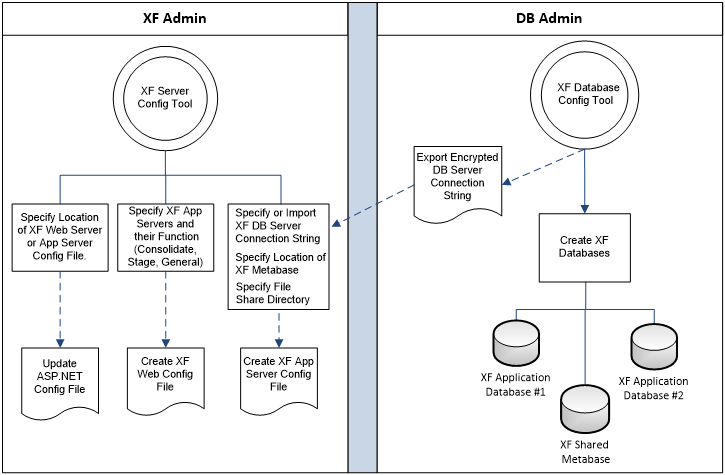OneStream’s Configuration Files and Tools
OneStream utilizes three types of XML files to store its configuration information. Two of the configuration files are OneStream specific configuration files (XFWebServerConfig.xml & XFAppServerConfig.xml) and one of the files is a generic Microsoft ASP.net configuration file (Web.Config).
The generic Web.Config file is optionally used to store an alternate path to the OneStream specific configuration files. For example, if multiple web servers want to share a common XFWebServerConfig.xml file, the common path should be set in the Web.config file of the OneStream web site on each web server. The same process applies to application servers that need to share a common XFAppServerConfig.xml file.

XFWebServerConfig.xml
This file is a proprietary OneStream xml file that contains configuration information specific to OneStream web servers. It should also be noted, that the web server configuration file defines the application server pool that is used by one or more web servers. This file can be accessed and maintained using the Server Configuration Tool.
File Contents
-
Specifies application server pool
-
Defines application server usage
Stage
Performs data loading and transformation services only
Consolidation
Performs consolidations and calculation services only
General
Performs all services
Data Management
Performs data-related functions that can be very hardware-intensive.
Default Location
During the web server installation, the OneStream server installation package creates an empty version of the XFWebServerConfig.xml file in the App Data folder in the virtual directory created for the OneStream web server application.
Default Web Server XFWebServerConfig.xml Path
C:\Program Files\OneStream Software\OneStreamWebRoot\OneStreamWeb\App_Data\XFWebServerConfig.xml
XFAppServerConfig.xml
This file is a proprietary OneStream xml file that contains configuration information specific to OneStream application servers. This file can be accessed and maintained using the OneStream Server Configuration Tool.
File Contents
-
Database server connection information (Optionally Encrypted)
-
File share directory location
-
Application server threshold/limit settings
-
Application server threading model settings
-
System culture settings
-
Environment settings
-
Monitoring settings
-
Task Load Balancing settings
-
Azure subscription settings
-
Azure EDU level settings
-
Server Sets settings
Default Location
During the application server installation, an empty version of the XFAppServerConfig.xml file is created in the App Data folder in the virtual directory created for the OneStream application server application.
Default Application Server XFAppServerConfig.xml Path
C:\Program Files\OneStream Software\OneStreamAppRoot\OneStreamApp\App_Data\XFAppServerConfig.xml
Web.Config
This file is a standard Microsoft ASP.Net configuration file that exists on the web and application server. This file specifies settings that control how a Microsoft ASP.Net web site behaves. However, application specific information can be stored in this file to allow products running in an ASP.Net/IIS web site to store configuration information.
File Contents
OneStream optionally uses this file, on both the web and application servers, to store an alternative folder path for the OneStream specific configuration files. This setting allows web and/or application servers to create a shared folder for configuration files that can be used to share configuration files between servers. This file can be accessed and maintained using the Server Configuration Tool.
Default Location
During the web server and Application server installation process, the OneStream server installation package will create OneStreamWeb or OneStreamApp ASP.net virtual directory. The Web.Config file exists at the root of this virtual directory.
Default web server Web.Config path
C:\Program Files\OneStream Software\OneStreamWebRoot\OneStreamWeb\Web.Config
Web Server Security Hardening
The Web.config file is typically reviewed during server security scans by IT security teams and auditors. Numerous security scanning tools may be used during these audits. OneStream recommends making the changes identified in Appendix 7: Web.config Hardening Process Overview for optimal security and consistent scanning results.
[Encrypted Database Connections].xml
OneStream allows for optional separation of duties between application server administrators and database server administrators. Database connection information can be protected limiting the use of the OneStream Database Configuration Utility to database administrators.
This utility enables database administrators to create and maintain connections and schemas in the relational database system and simply provide an xml file containing encrypted database connection information to application server administrator. The application server administrator can simply import the contents of the encrypted database connection xml file into the XFAppServerConfig.xml file using the OneStream Server Configuration Tool.